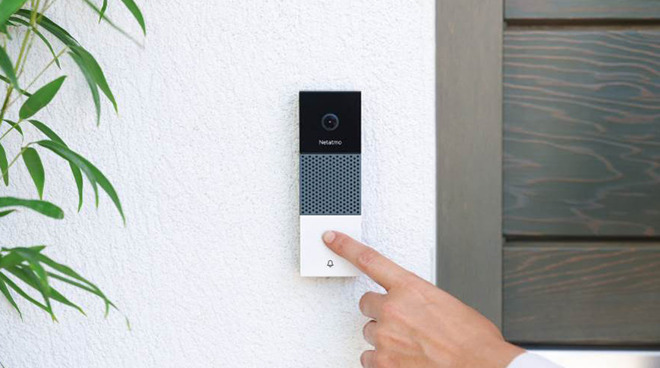Netatmo announces U.S. availability of HomeKit video doorbell
Originally debuted at 2019's CES, Netatmo will soon be bringing its HomeKit-compatible Smart Video Doorbell to U.S. customers in early January

Netatmo's Smart Video Doorbell has a 140-degree field of view, smart HDR technology to handle backlit scenes, infrared night vision, and locally recorded video. Thanks to a thin-film coating, it's IP44 rated and is entirely waterproof and dustproof.
The Smart Video Doorbell utilizes Artificial Intelligence algorithms to identify between random motion and a person approaching the door. Its built-in microphone and speaker allows users to communicate with guests, delivery people, or strangers at the door. A customizable Alert-Zone enables users to define what areas will trigger motion alerts and which won't.
Homekit users can create custom scenarios to connect their doorbell to other devices, too. For instance, if the doorbell detects a person, it could turn on HomeKit-compatible lights. Additionally, users can utilize Siri to show them their front door with simple voice commands.
While Netatmo has a somewhat higher price tag, it includes premium features and no monthly fee, a departure from many other smart video doorbell brands. Users can also install the Smart Video Doorbell themselves by replacing an existing doorbell.
HomeKit Secure Video is not supported at launch. As it stands, HomeKit support allows users to call up the camera using Siri, trigger scenes or lights based on detected motion, and view the camera from the Home app. Netatmo is still promising HSV, but it will be arriving at a later date as an automatic firmware update.
Netatmo's Smart Video Doorbell will be available on January 6 but will be available to preorder from Amazon and Netatmo's online shop starting today for $299.99.

Netatmo's Smart Video Doorbell has a 140-degree field of view, smart HDR technology to handle backlit scenes, infrared night vision, and locally recorded video. Thanks to a thin-film coating, it's IP44 rated and is entirely waterproof and dustproof.
The Smart Video Doorbell utilizes Artificial Intelligence algorithms to identify between random motion and a person approaching the door. Its built-in microphone and speaker allows users to communicate with guests, delivery people, or strangers at the door. A customizable Alert-Zone enables users to define what areas will trigger motion alerts and which won't.
Homekit users can create custom scenarios to connect their doorbell to other devices, too. For instance, if the doorbell detects a person, it could turn on HomeKit-compatible lights. Additionally, users can utilize Siri to show them their front door with simple voice commands.
While Netatmo has a somewhat higher price tag, it includes premium features and no monthly fee, a departure from many other smart video doorbell brands. Users can also install the Smart Video Doorbell themselves by replacing an existing doorbell.
HomeKit Secure Video is not supported at launch. As it stands, HomeKit support allows users to call up the camera using Siri, trigger scenes or lights based on detected motion, and view the camera from the Home app. Netatmo is still promising HSV, but it will be arriving at a later date as an automatic firmware update.
Netatmo's Smart Video Doorbell will be available on January 6 but will be available to preorder from Amazon and Netatmo's online shop starting today for $299.99.

Comments
In addition, I discovered during installation that the Logitech doorbell requires you to abandon any rear door bell you might have. That's absurd. I returned my unit and will wait for someone to offer a doorbell suitable for its intended purpose.
As to the two doorbell issue I think that's trickier than people think. These doorbells are using some kind of wizardry to use the same single circuit from the chime to the doorbell for both power to run the electronics in the doorbell and to sound the chime. Pressing a normal dummy doorbell just completes the circuit to send power to the chime but I don't know how these two smart doorbells can both get power to run themselves without turning the chime on and then also use the same power circuit to turn the chime on. Getting two doorbells to do that with the same chime seems impossible. My guess is getting a separate chime for the rear doorbell would work fine and having a separate chime with a different sound would also tell you which doorbell was pressed.
As for operating two doorbells, that's also a trivial bit of engineering (I retired from designing medical electronic instrumentation after a 40 year career). The doorbell unit can sip power from the doorbell circuit in the same way as the light bulbs commonly found in old mechanical doorbells do. The doorbell is in series with the chime solenoid. So long as the doorbell (whether a bulb or smart electronics) does not pass enough current to pull in the solenoid, pressing the button will pull it in and make the chiming sound. The second doorbell button drives a completely independent solenoid (which usually strikes only the shorter of the two tone plates, making a single "ding" on press). I don't understand why Logitech would require abandoning the second door bell, as it's really an independent circuit capable of operating on its own.
It's pretty rare for me to see engineering errors like this in modern products. Logitech's effort with the Circle View is quite disappointing.
I think you're right about how the power is sipped through the single circuit. If your second doorbell is on a separate circuit then I don't see how that can be a problem. Perhaps Logitech is implying the case where two doorbells are connected to the same solenoid. I would definitely not remove the other doorbell and if the your Logitech doorbell can handle the climate range in Wisconsin I would even dare to install a second one.
https://www.reddit.com/r/HomeKit/comments/k9z0vr/logitech_circle_view_wired_doorbell_overheating/